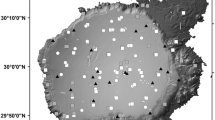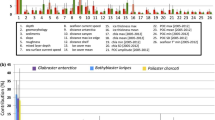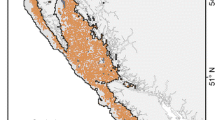Abstract
Biodiversity is critical for maintaining and stabilizing ecosystem processes. There is a need for high-resolution biodiversity maps that cover large sea areas in order to address ecological questions related to biodiversity-ecosystem functioning relationships and to provide data for marine environmental protection and management decisions. However, traditional sampling-point-wise field work is not suitable for covering extensive areas in high detail. Spatial predictive modeling using biodiversity data from sampling points and georeferenced environmental data layers covering the whole study area is a potential way to create biodiversity maps for large spatial extents. Random forest (RF), generalized additive models (GAM), and boosted regression trees (BRT) were used in this study to produce benthic (macroinvertebrates, macrophytes) biodiversity maps in the northern Baltic Sea. Environmental raster layers (wave exposure, salinity, temperature, etc.) were used as independent variables in the models to predict the spatial distribution of species richness. A validation dataset containing data that was not included in model calibration was used to compare the prediction accuracy of the models. Each model was also evaluated visually to check for possible modeling artifacts that are not revealed by mathematical validation. All three models proved to have high predictive ability. RF and BRT predictions had higher correlations with validation data and lower mean absolute error than those of GAM. Both mathematically and visually, the predictions by RF and BRT were very similar. Depth and seabed sediments were the most influential abiotic variables in predicting the spatial patterns of biodiversity.




Similar content being viewed by others
References
Austin MP (2002) Spatial prediction of species distribution: an interface between ecological theory and statistical modelling. Ecol Model 157:101–118
Bѐgin C, Johnson LE, Himmelman JH (2004) Macroalgal canopies: distribution and diversity of associated invertebrates and effects on the recruitment and growth of mussels. Mar Ecol Prog Ser 271:121–132
Bendtsen J, Gustafsson KE, Söderkvist J, Hansen JLS (2009) Ventilation of bottom water in the North Sea–Baltic Sea transition zone. J Marine Syst 75:138–149
Boero F, Bonsdorff E (2007) A conceptual framework from marine biodiversity and ecosystem functioning. Mar Ecol 28:134–145
Bonsdorff E (2006) Zoobenthic diversity-gradients in the Baltic Sea: continuous post-glacial succession in a stressed ecosystem. J Exp Mar Biol Ecol 330:383–391
Boström C, Bonsdorff E (2000) Zoobenthic community establishment and habitat complexity—the importance of seagrass shoot-density, morphology and physical disturbance for faunal recruitment. Mar Ecol Prog Ser 205:123–138
Breiman L, Cutler A, Liaw A, Wiener M (2015) randomForest: Breiman and Cutler’s random forests for classification and regression. R package version 4:6–12 http://cran.r-project.org/. Accessed 11 December 2016
Brown CJ, Mitchell A, Limpenny DS, Robertson MR, Service M, Golding N (2005) Mapping seabed habitats in the firth of Lorn off the west coast of Scotland: evaluation and comparison of habitat maps produced using the acoustic ground-discrimination system, RoxAnn, and sidescan sonar. ICES J Mar Sci 62:790–802
Brown CJ, Smith SJ, Lawton P, Anderson JT (2011) Benthic habitat mapping: a review of progress towards improved understanding of the spatial ecology of the seafloor using acoustic techniques. Estuar Coast Shelf Sci 92:502–520
Burrows MT, Schoeman DS, Buckley LB, Moore P, Poloczanska ES, Brander KM et al (2011) The pace of shifting climate in marine and terrestrial ecosystems. Science 334:652–655
Campbell V, Murphy G, Romanuk TN (2011) Experimental design and the outcome and interpretation of diversity–stability relations. Oikos 120:399–408
Cardinale BJ, Duffy JE, Gonzalez A, Hooper DU, Perrings C, Venail P et al (2012) Biodiversity loss and its impact on humanity. Nature 486:59–67
Crase B, Liedloff A, Vesk PA, Fukuda Y, Wintle BA (2014) Incorporating spatial autocorrelation into species distribution models alters forecasts of climate-mediated range shifts. Glob Change Biol 20:2566–2579
Dormann CF (2007) Effects of incorporating spatial autocorrelation into the analysis of species distribution data. Global ecol Biogeogr 16:129-138s
Dunstan PK, Althaus F, Williams A, Bax NJ (2012) Characterising and predicting benthic biodiversity for conservation planning in deepwater environments. PLoS One 7(5):e36558
Eleftheriou A, McIntyre AD (2005) Methods for the study of marine benthos, 3rd edn. Blackwell, Oxford
Elith J, Graham CH, Anderson RP, Dudik M, Ferrier S, Guisan A et al (2006) Novel methods improve prediction of species’ distributions from occurrence data. Ecography 29:129–151
Elith J, Leathwick JR, Hastie T (2008) A working guide to boosted regression trees. J Anim Ecol 77:802–813
Elith J, Leathwick JR (2009) Species distribution models: ecological explanation and prediction across space and time. Annu Rev Ecol Evol S40:677–697
Elith J and Leathwick JR (2016) Boosted Regression Trees for ecological modeling. https://cran.r-project.org/web/packages/dismo/vignettes/brt.pdf. Accessed 11 December 2016
Ellingsen KE, Clarke KR, Somerfield PJ, Warwick RM (2005) Taxonomic distinctness as a measure of diversity applied over a large scale: the benthos of the Norwegian continental shelf. J Anim Ecol 74:1069–1079
Elliott JM, Drake CM (1981) A comparative study of seven grabs used for sampling benthic macroinvertebrates in rivers. Freshw Biol 11:99–120
Feilhauer H, Schmidtlein S (2009) Mapping continuous fields of forest alpha and beta diversity. Appl Veg Sci 12:429–439
Finnish Ministry of the Environment (2014) Finnish marine management monitoring handbook. http://www.ymparisto.fi/download/noname/%7BECF9A983-AC50-4DAB-B237-D7EA3A09664B%7D/103978. Accessed 11 December 2016
Ferrari R, McKinnon D, He H, Smith RN, Corke P, González-Rivero M, Mumby PJ, Upcroft B (2016) Quantifying multiscale habitat structural complexity: a cost-effective framework for underwater 3D modelling. Remote Sens 8:113
Flannagan JF (1970) Efficiencies of various grabs and corers in Sarnpling freshwater benthos. J Fish Res 27:169l–1700
Friedman JH, Hastie T, Tibshirani R (2000) Additive logistic regression: a statistical view of boosting. Ann Stat 28:337–407
Fuchs S, Balling N (2016) Improving the temperature predictions of subsurface thermal models by using high-quality input data. Part 1: uncertainty analysis of the thermal-conductivity parameterization. Geothermics 64:1–14
Gladstone W (2007) Requirements for marine protected areas to conserve the biodiversity of rocky reef fishes. Aquat Conserv Mar fReshw Ecosys 17:71–87
González-Rivero M, Beijbom O, Rodriguez-Ramirez A, Holtrop T, González-Marrero Y, Ganase A, Roelfsema C, Phinn S, Hoegh-Guldberg O (2016) Scaling up ecological measurements of coral reefs using semi-automated field image collection and analysis. Remote Sens 8:30
Gray JS (2001) Marine diversity: the paradigms in patterns of species richness examined. Sci Mar 65:41–56
Gruszka P (1999) The river Odra estuary as a gateway for alien species immigration to the Baltic Sea basin. Acta Hydrochim Hydrobiol 27:374–382
Guisan A, Thuiller W (2005) Predicting species distribution: offering more than simple habitat models. Ecol Lett 8:993–1009
Guisan A, Zimmermann NE (2000) Predictive habitat distribution models in ecology. Ecol Model 135:147–186
Halpern BS, Walbridge S, Selkoe KA, Kappel CV, Micheli F, D’Agrosa C et al (2008) A global map of human impact on marine ecosystems. Science 319:948–952
Hansen JP, Wikström SA, Axemar H, Kautsky L (2011) Distribution differences and active habitat choices of invertebrates between macrophytes of different morphological complexity. Aquatic Ecol 45:11–22
Hastie TJ, Tibshirani RJ (1990) Generalised additive models. Chapman and Hall, New York
Hector A, Hautier Y, Saner P, Wacker L, Bagchi R, Joshi J et al (2010) General stabilizing effects of plant diversity on grassland productivity through population asynchrony and overyielding. Ecology 91:2213–2220
HELCOM (2009) Eutrophication in the Baltic Sea: An integrated thematic assessment of the effects of nutrient enrichment in the Baltic Sea Region. http://www.helcom.fi/Lists/Publications/BSEP115b.pdf. Accessed 11 December 2016
HELCOM (2013) HELCOM HUB: Technical Report on the HELCOM Underwater Biotope and habitat classification http://www.helcom.fi/Lists/Publications/BSEP139.pdf Accessed 31 May 2017
HELCOM (2015) Manual for Marine Monitoring in the COMBINE Programme of HELCOM. http://www.helcom.fi/action-areas/monitoring-and-assessment/manuals-and-guidelines/combine-manual. Accessed 11 December 2016
Herkül K, Kotta J (2009) Effects of eelgrass (Zostera marina) canopy removal and sediment addition on sediment characteristics and benthic communities in the northern Baltic Sea. Mar Ecol 30:74–82
Herkül K, Kotta J, Püss T, Kotta I (2009) Crustacean invasions in the Estonian coastal sea. Est J Ecol 58:313–323
Herkül K, Kotta J, Pärnoja M (2011) Effect of physical disturbance on the soft sediment benthic macrophyte and invertebrate community in the northern Baltic Sea. Boreal Env Res 16(suppl. A):209–219
Herkül K, Kotta J, Kutser T, Vahtmäe E (2013) Relating remotely sensed optical variability to marine benthic biodiversity. PLoS One 8:e55624
Herkül K, Torn K, Suursaar Ü, Alari V, Peterson A (2016) Variability of benthic communities in relation to hydrodynamic conditions in the north-eastern Baltic Sea. J Coast Res 75(sp1):867–871
Herkül K, Peterson A, Paekivi S (2017) Applying multibeam sonar and mathematical modeling for mapping seabed substrate and biota of offshore shallows. Estuar Coast Shelf S 192:57-71
Hooper DU, Chapin FS, Ewel JJ, Hector A, Inchausti P et al (2005) Effects of biodiversity on ecosystem functioning: a consensus of current knowledge. Ecol Monogr 75:3–35
Huang Z, Brooke BP, Harris PT (2011) A new approach to mapping marine benthic habitats using physical environmental data. Cont Shelf Res 31:S4–S16
Innes JL, Koch B (1998) Forest biodiversity and its assessment by remote sensing. Global Ecol Biogeogr Lett 7:397–419
Jänes H, Kotta J, Herkül K (2015) High fecundity and predation pressure of the invasive Gammarus tigrinus cause decline of indigenous gammarids. Estuar Coast Mar Sci 165:185–189
Kautsky H, Kautsky L, Kautsky N, Kautsky U, Lindblad C (1992) Studies on the Fucus vesiculosus community in the Baltic Sea. Acta Phytogeogr Suec 78:33–48
Karlson K, Rosenberg R, Bonsdorff E (2002) Temporal and spatial large-scale effects of eutrophication and oxygen deficiency on benthic fauna in Scandinavian and Baltic waters – a review. Oceanogr Mar Biol-An Annu Rev 40:427–489
Knudby A, LeDrew E, Brenning A (2010) Predictive mapping of reef fish species richness, diversity and biomass in Zanzibar using IKONOS imagery and machine-learning techniques. Remote Sens Environ 114:1230–1241
Kotta J, Orav H (2001) Role of benthic macroalgae in regulating macro- zoobenthic assemblages in the Väinameri (north-eastern Baltic Sea). Ann Zool Fenn 38:163–171
Kotta J, Lauringson V, Martin G, Simm M, Kotta I, Herkül K, Ojaveer H (2008) Gulf of Riga and Pärnu Bay. In: Schiewer U (ed) Ecology of Baltic coastal waters. Springer, Berlin Heidelberg, pp 217–243
Kuprijanov I, Herkül K, Kotta J (2017) Ecological niche differentiation between native and non-native shrimps in the northern Baltic Sea. Aquat Ecol 51. doi:10.1007/s10452-017-9624-5
Laine AO, Sandler H, Andersin A-B, Stigzelius J (1997) Long-term changes of macrozoobenthos in the eastern Gotland Basin and the Gulf of Finland (Baltic Sea) in relation to the hydrographical regime. J Sea Res 38:135–159
Lessin G, Raudsepp U, Stips A (2014) Modelling the influence of Major Baltic inflows on near-bottom conditions at the entrance of the Gulf of Finland. PLoS One 9:e112881
Levin LA (2003) Oxygen minimum zone benthos: adaptation and community response to hypoxia. Oceanogr Mar Biol Annu Rev 41:1–45
Liaw A, Wiener M (2002) Classification and regression by randomForest. R News 2:18–22
Lucieer V, Hill NA, Barrett NS, Nichol S (2013) Do marine substrates ‘look’ and ‘sound’ the same? Supervised classification of multibeam acoustic data using autonomous underwater vehicle images. Estuarine, Coast Shelf S 117:94–106
Magurran AE (2004) Measuring biological diversity. Blackwell Publishing, Oxford, p 256
Maljutenko I and Raudsepp U (2014) Validation of GETM model simulated long-term salinity fields in the pathway of saltwater transport in response to the Major Baltic Inflows in the Baltic Sea. 2014 IEEE/OES Baltic International Symposium (BALTIC), J. Carroll, Ed., Tallinn, IEEE/OES 23–31 http://ieeexplore.ieee.org/lpdocs/epic03/wrapper.htm?arnumber=6887830. Accessed 11 December 2016
Martin G, Kotta J, Möller T, Herkül K (2013) Spatial distribution of marine benthic habitats in the Estonian coastal sea, northeastern Baltic Sea. Estonian J Ecol 62:165–191
McArthur MA, Brooke BP, Przeslawski R, Ryan DA, Lucieer VL, Nichol S, McCallum AW, Mellin C, Cresswell ID, Radke LC (2010) On the use of abiotic surrogates to describe marine benthic biodiversity. Estuar Coast Shelf S 88:21–32
Nikolopoulos A, Isæus M (2008) Wave exposure calculations for the Estonian coast. AquaBiota Water Research AB, Stockholm, Sweden
Nagelkerken I, Connell SD (2015) Global alteration of ocean ecosystem functioning due to increasing human CO2 emissions. P Nat A Sci 112:13272–13277
Olabarria C (2006) Faunal change and bathymetric diversity gradient in deep-sea prosobranchs from northeastern Atlantic. Biodivers Conserv 15:3685–3702
R Core Team (2015) R: a language and environment for statistical computing. R Foundation for Statistical Computing, Vienna, Austria
Råberg S, Kautsky K (2007) A comparative biodiversity study of the associated fauna of perennial fucoids and filamentous algae. Estuar Coast Shelf S 73:249–258
Reisalu G, Kotta J, Herkül K, Kotta I (2016) The invasive amphipod Gammarus tigrinus sexton; 1939 displaces native gammarid amphipods from sheltered macrophyte habitats of the Gulf of Riga. Aquat Invasions 11:45–54
Reiss H, Birchenough S, Borja A, Buhl-Mortensen L, Craeymeersch J, Dannheim J et al (2014) Benthos distribution modelling and its relevance for marine ecosystem management. ICES J Mar Sci 72:297–315
Revermann R, Schmid H, Zbinden N, Spaar R, Schröder B (2012) Habitat at the mountain tops: how long can rock ptarmigan (Lagopus muta helvetica) survive rapid climate change in the Swiss alps? A multi-scale approach. J Ornithol 153:891–905
Ridgeway G (2007) Generalized Boosted Models: A guide to the gbm package. http://www.saedsayad.com/docs/gbm2.pdf. Accessed 11 December 2016
Robinson LM, Elith J, Hobday AJ, Pearson RG, Kendall BE, Possingham HP, Richardson AJ (2011) Pushing the limits in marine species distribution modelling: lessons from the land present challenges and opportunities. Glob Ecol Biogeogr 20:789–802
Rousi H, Laine AO, Peltonen H, Kangas P, Andersin A-B, Rissanen J, Sandberg-Kilp E, Bonsdorff E (2013) Long-term changes in coastal zoobenthos in the northern Baltic Sea: the role of abiotic environmental factors. ICES J Mar Sci 70:440–451
Sanders JL, Kendall MA, Hawkins AJS, Spicer JI (2007) Can functional groups be used to indicate estuarine ecological status? Hydrobiologia 588:45–58
Schiedek D (1997) Marenzelleria Cf. Viridis (Polychaeta: Spionidae) — ecophysiological adaptations to a life in the coastal waters of the Baltic Sea. Aquat Ecol 31:199–210
Schubert H, Blindow I, eds. (2003) Charophytes of the Baltic Sea. Koeltz Scientific Books, pp 325
Snoeijs-Leijonmalm P, Schubert H, Radziejewska T (2017) Biological oceanography of the Baltic Sea. Springer, Netherlands
Steinhardt T, Selig U (2007) Spatial distribution patterns and relationship between recent vegetation and diaspore bank of a brackish coastal lagoon on the southern Baltic Sea. Estuar Coast Shelf S 74:205–214
Stephens D and Diesing M (2014) A comparison of supervised classification methods for the prediction of substrate type using multibeam acoustic and legacy grain-size data. PLoS One 9: e93950
Suursaar Ü, Alari V, Tõnisson H (2014) Multi-scale analysis of wave conditions and coastal changes in the north-eastern Baltic Sea. J Coastal Res 70:223–228
Swedish Agency for Marine and Water Management (2016) Environmental monitoring programs in the seas and coastal areas. https://www.havochvatten.se/hav/vagledning--lagar/vagledningar/ovriga-vagledningar/miljoovervakningens-metoder-och-undersokningstyper-inom-programomrade-kust-och-hav.html. Accessed 11 December 2016
Tilman D, Reich PB, Knops JMH (2006) Biodiversity and ecosystem stability in a decade-long grassland experiment. Nature 441:629–632
Torn K, Kovtun-Kante A, Herkül K, Martin G, Mäemets H (2015) Distribution and predictive occurrence model of charophytes in Estonian waters. Aquat Bot 120:142–149
Torn K, Herkül K, Martin G, Oganjan K (2017) Assessment of quality of three marine benthic habitat types in northern Baltic Sea. Ecol Indic 73:772–783
Väli G, Meier HEM, Elken J (2013) Simulated halocline variability in the Baltic Sea and its impact on hypoxia during 1961–2007. J Geophys Res-Oceans 118:6982–7000
VELMU (2016) The Finnish Inventory Programme for the Underwater Marine Environment, VELMU. http://www.ymparisto.fi/fi-FI/VELMU. Accessed 11 December 2016
Villnäs A, Norkko J, Hietanen S, Josefson AB, Lukkari K, Norkko A (2013) The role of recurrent disturbances for ecosystem multifunctionality. Ecology 94:2275–2287
Vitousek PM, Mooney HA, Lubchenco J, Melillo JM (1997) Human domination of Earth’s ecosystems. Science 277:494–499
Wisz MS, Hijmans RJ, Li J, Peterson AT, Graham CH, Guisan A, Distribut NPS (2008) Effects of sample size on the performance of species distribution models. Divers Distrib 14:763–773
Wood SN (2011) Fast stable restricted maximum likelihood and marginal likelihood estimation of semiparametric generalized linear models. J R Stat Soc 73:3–36
Worm B, Barbier EB, Beaumont N, Duffy JE, Folke C, Halpern BS (2006) Impacts of biodiversity loss on ocean ecosystem services. Science 314:787–790
Zajac RN (2008) Macrobenthic biodiversity and sea floor landscape structure. J Exp Mar Biol Ecol 366:198–203
Zettler ML, Karlsson A, Kontula T, Gruszka P, Laine AO, Herkül K, Schiele KS, Maximov A, Haldin J (2013) Biodiversity gradient in the Baltic Sea: a comprehensive inventory of of macrozoobenthos data. Helgoland Mar Res 68:49–57
Zimmermann NE, Edwards TC Jr, Graham CH, Pearman PB, Svenning J-C (2010) New trends in species distribution modelling. Ecography 33:985–989
Acknowledgements
This work was supported by the institutional research funding IUT02-20 of the Estonian Ministry of Education and Research. The project has received funding from the BONUS project BIO-C3, the Joint Baltic Sea Research and Development Programme (Art 185), funded jointly from the European Union’s Seventh Programme for Research, Technological Development and Demonstration, and from the Estonian Research Council. The authors thank Kiran Liversage for the language revision.
Author information
Authors and Affiliations
Corresponding author
Additional information
Communicated by D. M. Paterson
Appendices
Appendix 1
Appendix 2 Partial dependence plots of the random forest models that were used for making spatial predictions
Rights and permissions
About this article
Cite this article
Peterson, A., Herkül, K. Mapping benthic biodiversity using georeferenced environmental data and predictive modeling. Mar Biodiv 49, 131–146 (2019). https://doi.org/10.1007/s12526-017-0765-5
Received:
Revised:
Accepted:
Published:
Issue Date:
DOI: https://doi.org/10.1007/s12526-017-0765-5







